Sand Croton
Croton glandulosus septentrionalis
Spurge family (Euphorbiaceae)
Croton glandulosus septentrionalis
Spurge family (Euphorbiaceae)
Description:
This herbaceous plant is a summer annual about ½–1½' (15–45 cm.) tall,
branching occasionally. Lateral stems arch upward from the central
stem. The stems are greenish brown to brown, terete, and moderately
covered with white-stellate hairs. Leaves are alternate, subopposite
(nearly opposite), or in pseudo-whorls underneath the inflorescences.
Individual leaves are ¾–3" (2–7.5 cm.) long, dentate along their
margins, and either oblong-elliptic or oblong-lanceolate in shape. The
upper leaf surface is medium green and sparsely covered with
white-stellate hairs, while the lower leaf surface is light green and
moderately covered with white-stellate hairs. Leaf venation is pinnate.
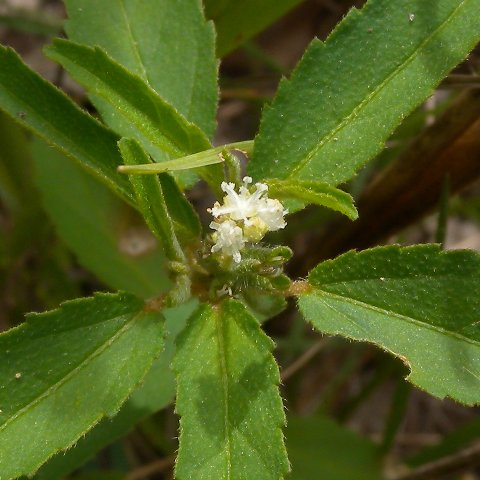
The narrow petioles of the leaves are ¼–¾" (6–20 mm.) long, light brown, and moderately covered with white-stellate hairs. At the terminal end of each petiole, where it joins the leaf blade, there is a pair of yellowish nectaries. This plant species is monoecious with both staminate (male) and pistillate (female) flowers developing on the same plant. The staminate flowers are located above on a short stalk, while the pistillate flowers are nearly sessile and arranged in clusters of 2–3. Each staminate flower has a green calyx with 4–5 narrowly oblong lobes, 4–5 spreading white petals that are linear-oblong in shape, and 8–10 white stamens; it is about 2 mm. tall and across. Each pistillate flower has a green calyx with 4-5 narrowly oblong-oblanceolate lobes, a globoid-ovoid green ovary, 3 deeply bifurcated styles, and a nectar disk; it is about 4–5 mm. tall and a little less across. The calyces of both types of flower are moderately covered with white-stellate hairs, while the ovaries are sparsely covered with white-stellate hairs.
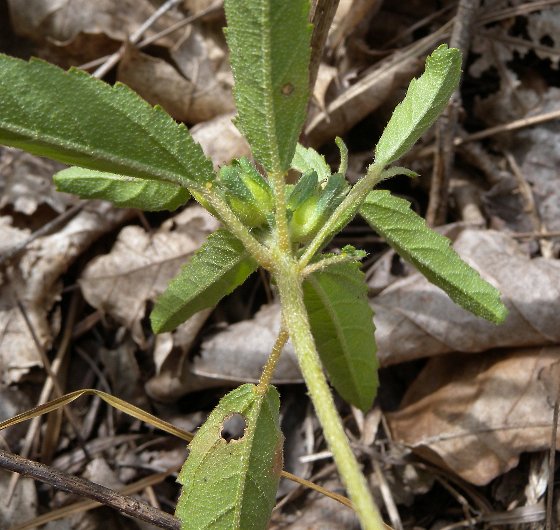
The blooming period occurs sporadically from mid-summer to early autumn, lasting about 2 months. Afterwards, the staminate flowers soon wither away, while the ovaries develop into 3-celled seed capsules about 5–6 mm. long and a little less across. Each cell of the capsule contains a single seed. The seeds are 3–4 mm. long, ovoid and somewhat flattened, and light to dark brown; they have a fine pebbly surface. At one end, each seed has a yellow to orange swollen appendage (caruncle). The seeds are distributed to some extent by mechanical ejection. The root system consists of a fine taproot with some spreading lateral roots. This plant reproduces by reseeding itself.
Cultivation: The preference is full or partial sun, mesic to dry conditions, and open sandy soil.
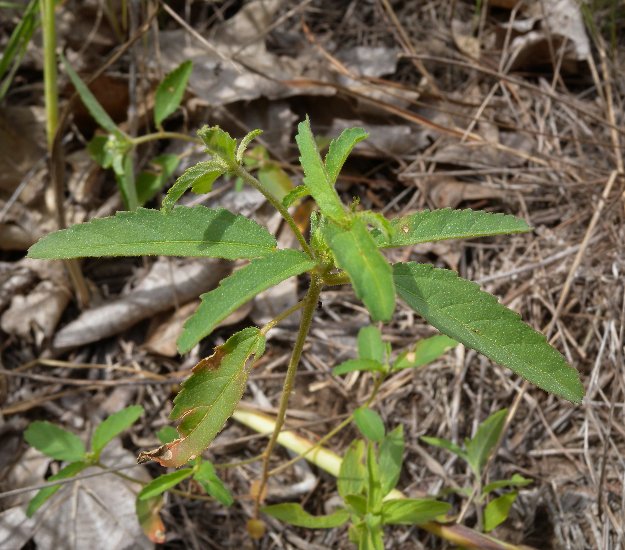
Range & Habitat: Sand Croton (Croton glandulosus septentrionalis) is occasional throughout Illinois; it is especially common in sandy areas, but uncommon elsewhere (see Distribution Map). This plant is probably native to many areas of central and southern Illinois, but it is likely adventive in northern Illinois. Habitats include open sandy woodlands, sandy savannas, sand prairies, sandy cropland and pastures, roadsides and areas along railroads, abandoned sandy fields, and waste areas. Sand Croton can be found in both higher quality habitats and degraded habitats, especially where there is some history of wildfire or other disturbance. When this plant is found in wooded areas, either Black Oaks (Quercus velutina) and/or Blackjack Oaks (Quercus marilandica) are often the dominant canopy trees.
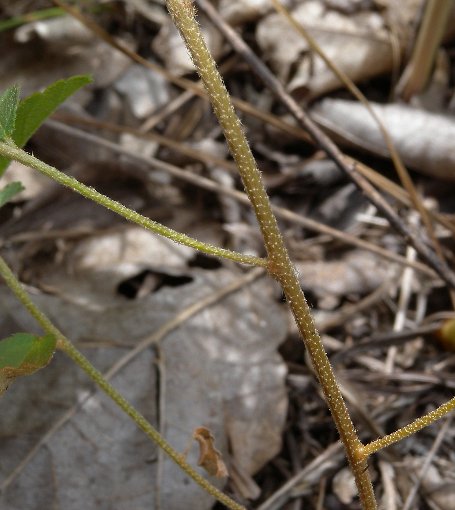
Faunal Associations: The small flowers offer pollen or nectar as floral rewards to insects visitors; this probably includes Syrphid flies, small bees, and wasps. In addition, the extrafloral nectaries on the petioles of this plant attract bees, wasps, and ants (Wilhelm & Rericha, 2017). The ants may help to defend this plant from small insects that feed on plant tissue or sap. The swollen appendages on the seeds attract ants; these insects spread the seeds to new areas (Kirkman, 2018). The caterpillars of Anaea andria (Goatweed Butterfly) feed on the foliage of this plant and other Croton spp. The adults of a flea beetle, Syphrea nana, also feed on the foliage, while its larvae probably feed on the roots (Bouseman & Sternburg, 2001; Clark et al., 2004). Among vertebrate animals, the following birds are known to eat the seeds: Mourning Dove, Lark Sparrow, White-crowned Sparrow, Brown-headed Cowbird, and Bobwhite Quail (Martin et al., 1951/1961). The foliage of this plant is avoided by mammalian herbivores.
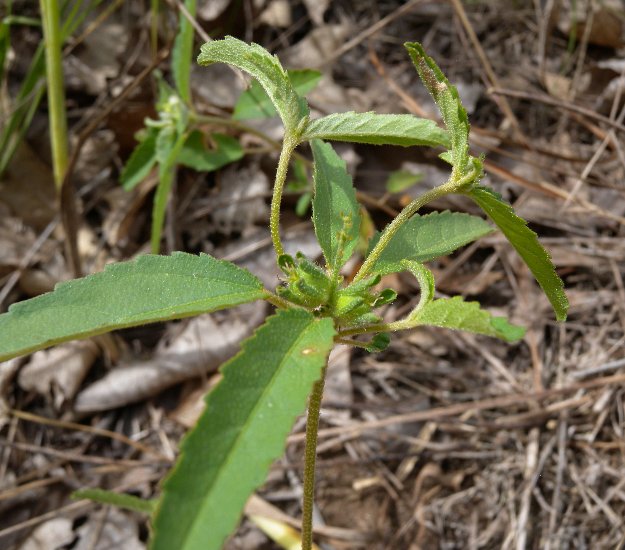
Photographic Location: Border zone of a sandy woodland and sand prairie at the Sand Prairie & Scrub Oak Nature Preserve in Mason County, Illinois.
Comments: There are several native Croton spp. that occur in Illinois. Sand Croton (Croton glandulosus septentrionalis) can be easily distinguished from these other species by the toothed margins of its leaves. It also has some resemblance to native Crotonopsis spp., but the latter have more narrow leaves. The typical variety of Sand Croton, Croton glandulosus glandulosus, is a taller plant with larger leaves. This latter variety is found no further north than Florida in the United States.

The narrow petioles of the leaves are ¼–¾" (6–20 mm.) long, light brown, and moderately covered with white-stellate hairs. At the terminal end of each petiole, where it joins the leaf blade, there is a pair of yellowish nectaries. This plant species is monoecious with both staminate (male) and pistillate (female) flowers developing on the same plant. The staminate flowers are located above on a short stalk, while the pistillate flowers are nearly sessile and arranged in clusters of 2–3. Each staminate flower has a green calyx with 4–5 narrowly oblong lobes, 4–5 spreading white petals that are linear-oblong in shape, and 8–10 white stamens; it is about 2 mm. tall and across. Each pistillate flower has a green calyx with 4-5 narrowly oblong-oblanceolate lobes, a globoid-ovoid green ovary, 3 deeply bifurcated styles, and a nectar disk; it is about 4–5 mm. tall and a little less across. The calyces of both types of flower are moderately covered with white-stellate hairs, while the ovaries are sparsely covered with white-stellate hairs.

The blooming period occurs sporadically from mid-summer to early autumn, lasting about 2 months. Afterwards, the staminate flowers soon wither away, while the ovaries develop into 3-celled seed capsules about 5–6 mm. long and a little less across. Each cell of the capsule contains a single seed. The seeds are 3–4 mm. long, ovoid and somewhat flattened, and light to dark brown; they have a fine pebbly surface. At one end, each seed has a yellow to orange swollen appendage (caruncle). The seeds are distributed to some extent by mechanical ejection. The root system consists of a fine taproot with some spreading lateral roots. This plant reproduces by reseeding itself.
Cultivation: The preference is full or partial sun, mesic to dry conditions, and open sandy soil.

Range & Habitat: Sand Croton (Croton glandulosus septentrionalis) is occasional throughout Illinois; it is especially common in sandy areas, but uncommon elsewhere (see Distribution Map). This plant is probably native to many areas of central and southern Illinois, but it is likely adventive in northern Illinois. Habitats include open sandy woodlands, sandy savannas, sand prairies, sandy cropland and pastures, roadsides and areas along railroads, abandoned sandy fields, and waste areas. Sand Croton can be found in both higher quality habitats and degraded habitats, especially where there is some history of wildfire or other disturbance. When this plant is found in wooded areas, either Black Oaks (Quercus velutina) and/or Blackjack Oaks (Quercus marilandica) are often the dominant canopy trees.

Faunal Associations: The small flowers offer pollen or nectar as floral rewards to insects visitors; this probably includes Syrphid flies, small bees, and wasps. In addition, the extrafloral nectaries on the petioles of this plant attract bees, wasps, and ants (Wilhelm & Rericha, 2017). The ants may help to defend this plant from small insects that feed on plant tissue or sap. The swollen appendages on the seeds attract ants; these insects spread the seeds to new areas (Kirkman, 2018). The caterpillars of Anaea andria (Goatweed Butterfly) feed on the foliage of this plant and other Croton spp. The adults of a flea beetle, Syphrea nana, also feed on the foliage, while its larvae probably feed on the roots (Bouseman & Sternburg, 2001; Clark et al., 2004). Among vertebrate animals, the following birds are known to eat the seeds: Mourning Dove, Lark Sparrow, White-crowned Sparrow, Brown-headed Cowbird, and Bobwhite Quail (Martin et al., 1951/1961). The foliage of this plant is avoided by mammalian herbivores.

Photographic Location: Border zone of a sandy woodland and sand prairie at the Sand Prairie & Scrub Oak Nature Preserve in Mason County, Illinois.
Comments: There are several native Croton spp. that occur in Illinois. Sand Croton (Croton glandulosus septentrionalis) can be easily distinguished from these other species by the toothed margins of its leaves. It also has some resemblance to native Crotonopsis spp., but the latter have more narrow leaves. The typical variety of Sand Croton, Croton glandulosus glandulosus, is a taller plant with larger leaves. This latter variety is found no further north than Florida in the United States.